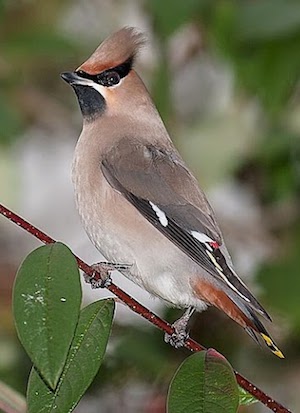Bombycillidae – Waxwings

Bombycillidae commonly called waxwings are passerines in the genus Bombycilla. According to most authorities, this is the only genus placed in the family Bombycillidae, although Phainoptila was sometimes previously included.
Waxwings are not long-distance migrants, but move nomadically outside the breeding season. They mostly feed on fruit.
Waxwings are characterised by soft silky plumage. (Bombycilla, the genus name, was coined by Vieillot; his attempt at Latin for ‘silktail’, translating the German name Seidenschwänze.) They have unique red tips to some of the wing feathers where the shafts extend beyond the barbs; in the Bohemian Waxwing and Cedar Waxwing, these tips look like sealing wax, and give the group its common name. Their legs are short and strong, and their wings are pointed. The male and female have the same plumage. All three species have mainly light brown to beige plumage, a black line through the eye and black under the chin, a square-ended tail with a red or yellow tip, and a pointed crest. The bill, eyes, and feet are dark. Calls are high-pitched, buzzing or trilling monosyllables.
They are arboreal birds that breed in northern forests. Their main food is fruit, which they eat from early summer (strawberries, mulberries, and serviceberries) through late summer and autumn (raspberries, blackberries, cherries, and honeysuckle berries) into late autumn and winter (juniper berries, grapes, crabapples, mountain ash fruits, rose hips, cotoneaster fruits, dogwood berries, and mistletoe berries). They pluck fruit from a perch or occasionally while hovering. In spring they replace fruit with sap, buds, and flowers. In the warmer part of the year they catch many insects by gleaning or in midair, and often nest near water where flying insects are abundant. They will catch insects at anytime of the year when they are more easily available than fruit
Waxwings also choose nest sites in places with rich supplies of fruit and breed late in the year to take advantage of summer ripening. However, they may start courting as early as the winter. Pairing includes a ritual in which mates pass a fruit or small inedible object back and forth several times until one eats it (if it is a fruit). After this they may copulate. So that many birds can nest in places with good food supplies, a pair does not defend a territory, perhaps the reason waxwings have no true song, but a bird may attack intruders, perhaps to guard its mate. Both birds gather nest materials, but the female does most of the construction, usually on a horizontal limb or in a crotch well away from the tree trunk, at any height. She makes a loose, bulky nest of twigs, grass, and lichen, which she lines with fine grass, moss, and pine needles and may camouflage with dangling pieces of grass, flowers, lichen, and moss. The female incubates, fed by the male on the nest, but once the eggs hatch, both birds feed the young.
They are not true long-distance migrants, but wander erratically outside the breeding season and move south from their summer range in winter. In poor berry years huge numbers can erupt well beyond their normal range, often in flocks that on occasion number in the thousands.
There are just three species in this family; they are:
Bohemian Waxwing Bombycilla garrulus
Japanese Waxwing Bombycilla japonica
Cedar Waxwing Bombycilla cedrorum
-
Bohemian Waxwing Bombycilla garrulus
Species AccountSound archive and distribution map. -
Bohemian Waxwing Bombycilla garrulus
Species AccountThe Bohemian waxwing (Bombycilla garrulus) is a starling-sized passerine bird that breeds in the northern forests of Eurasia and North America. -
Bohemian Waxwing Bombycilla garrulus
Cornell Species AccountThe Bohemian Waxwing is an irregular winter visitor from the far North. -
Bohemian Waxwing Bombycilla garrulus
RSPB Species Accounthe waxwing is a plump bird, which is slightly smaller than a starling. It has a prominent crest. -
Cedar Waxwing Ampelis cedrorum
Species AccountSound archive and distribution map. -
Cedar Waxwing Ampelis cedrorum
Species AccountThe cedar waxwing (Bombycilla cedrorum) is a member of the family Bombycillidae or waxwing family of passerine birds. -
Cedar Waxwing Ampelis cedrorum
Cornell Species AccountA treat to find in your binocular viewfield, the Cedar Waxwing is a silky, shiny collection of brown, gray, and lemon-yellow, accented with a subdued crest, rakish black mask, and brilliant-red wax droplets on the wing feathers. -
Japanese Waxwing Bombycilla japonica
Species AccountSound archive and distribution map. -
Japanese Waxwing Bombycilla japonica
Species AccountThe Japanese waxwing (Bombycilla japonica) is a fairly small passerine bird of the waxwing family found in north-east Asia. It feeds mainly on fruit and berries but also eats insects during the summer. The nest is a cup of twigs lined with grass and moss which is built in a tree.
-
Number of bird species: 3
